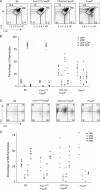Lack of Foxp3 function and expression in the thymic epithelium
- PMID: 17353370
- PMCID: PMC2137899
- DOI: 10.1084/jem.20062465
Lack of Foxp3 function and expression in the thymic epithelium
Abstract
Foxp3 is essential for the commitment of differentiating thymocytes to the regulatory CD4(+) T (T reg) cell lineage. In humans and mice with a genetic Foxp3 deficiency, absence of this critical T reg cell population was suggested to be responsible for the severe autoimmune lesions. Recently, it has been proposed that in addition to T reg cells, Foxp3 is also expressed in thymic epithelial cells where it is involved in regulation of early thymocyte differentiation and is required to prevent autoimmunity. Here, we used genetic tools to demonstrate that the thymic epithelium does not express Foxp3. Furthermore, we formally showed that genetic abatement of Foxp3 in the hematopoietic compartment, i.e. in T cells, is both necessary and sufficient to induce the autoimmune lesions associated with Foxp3 loss. In contrast, deletion of a conditional Foxp3 allele in thymic epithelial cells did not result in detectable changes in thymocyte differentiation or pathology. Therefore, in mice the only known role for Foxp3 remains promotion of T reg cell differentiation within the T cell lineage, whereas there is no role for Foxp3 in thymic epithelial cells.
Figures




References
-
- Bennett, C.L., and H.D. Ochs. 2001. IPEX is a unique X-linked syndrome characterized by immune dysfunction, polyendocrinopathy, enteropathy, and a variety of autoimmune phenomena. Curr. Opin. Pediatr. 13:533–538. - PubMed
-
- Ferguson, P.J., S.H. Blanton, F.T. Saulsbury, M.J. McDuffie, V. Lemahieu, J.M. Gastier, U. Francke, S.M. Borowitz, J.L. Sutphen, and T.E. Kelly. 2000. Manifestations and linkage analysis in X-linked autoimmunity-immunodeficiency syndrome. Am. J. Med. Genet. 90:390–397. - PubMed
Publication types
MeSH terms
Substances
LinkOut - more resources
Full Text Sources
Molecular Biology Databases
Research Materials

